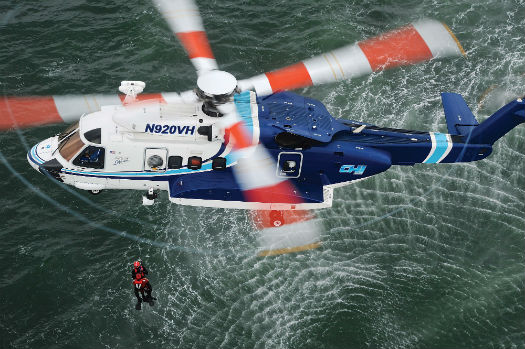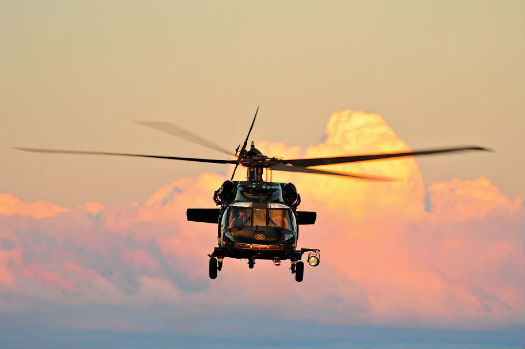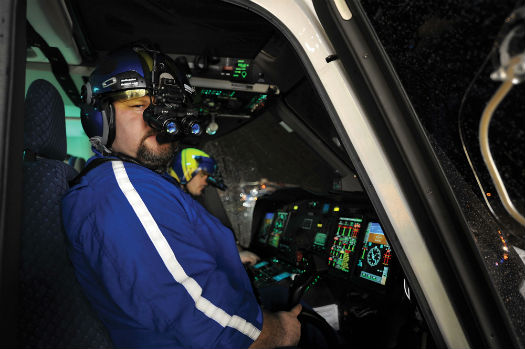
There are many opportunities in the civilian helicopter industry for military personnel to use the skills and experience they’ve developed during their years of service. CHI Aviation employs many ex-military personnel at its civilian search-and-rescue service in the Gulf of Mexico. Mike Reyno Photo
As my Coast Guard career comes to an end, I’m beginning to notice some changes. As we begin to gray, and reach the 20-year milestone, many of my buddies and I are thinking about our next move in life, or have already checked out of the United States Coast Guard (USCG). But after four years in the academy, and 17 years of active duty, I’m well aware that I’m officially institutionalized. I’m sure there are many military folks who, like me, wake up in the middle of the night worrying about the next move in life after our secure government job dumps us out into the “real” world, where no one’s named “Sir” anymore, and you’re finally free to grow that wonderful beard you’ve been longing for all those years.
But most of us in the military are completely clueless as to what the civilian helicopter industry is all about — what operations they do, what the competition is (and how we stack up), and the incredible diversity of jobs available. My skipper at a recent USCG air station told me he thought there was no better flying than at the USCG, and, because of this, said he wouldn’t be pursuing any work in the aviation sector after retiring. Another senior officer I spoke with said he’d made the same decision because he believed that civilian aviation puts profits ahead of safety. My suspicion is that neither one of these officers actually left the air station grounds to meet their civilian counterparts and find out for themselves what flying on the outside is really all about.
A former colleague of mine, BJ Miles, is the director of safety and risk management for Life Flight Network in the Northwest. He joined the operator after more than 20 years in the USCG. “Get out there and network,” he advised. “If all you do is fly Coast Guard, you don’t know jack or shit about flying civilian, or how their organizations work. Getting outside your base [and] comfort zone will bring you some level of awareness.”
HAI president Matt Zucarro has been involved in the rotary-wing industry for 45 years, joining the civilian helicopter world after serving in the U.S. Army in Vietnam. He said a meeting he had with a U.S. Army Major at the Army Aviation Association of America one year was a typical example of the lack of knowledge many have about their post-military employability. “We were having a conversation and he says, ‘You know, I’m a night vision instructor in the Black Hawk, have about 2,000 hours, and I’ve had command positions.’ And in all earnestness, he asked, ‘Do you think I can get a job?’ And I smiled at him and said, ‘You’re kidding, right? Of course you can get a job. Absolutely you can get a job. Your qualifications are great!’ ”

Many military personnel simply aren’t aware of just how employable they are to civilian operators, according to HAI’s Matt Zuccaro. Alexander Zamora Photo
An area where some military folks make an error is not converting their training and ability to the appropriate civilian certifications. If you’re head of maintenance, for example, and you don’t have your Airframe and/or Powerplant certificate, or you’re an over 3,000-hour instructor pilot and you don’t have your helicopter Airline Transport Pilot and your Certified Flight Instructor Instrument certificates, you could be making a big mistake.
“Adopt to the philosophy that getting a job is a job — and treat it that way,” said Zuccaro. “Get organized and educated on what you need to do. This is something you want to do almost a year or two ahead of time.”
Zuccaro is passionate about helping military aviators complete the transition into the civilian world, and said the skillsets developed during a career in the military make for strong candidates in the civilian marketplace.
“The experience is invaluable,” he said. “[You’re] flying complex aircraft, with multi-engine time, and NVG [night vision goggle] time for EMS [emergency medical services] and airborne law enforcement operations. It’s hard to replicate.” NVG time becomes more and more critical for EMS job resumes every year, as the sector continues moving towards NVGs as standard — and really, there’s no one better at this than the military aviator.
Another area where those in military stand out is in crew resource management (CRM). Mike Norris, a former USCG pilot who now flies EMS helicopters for REACH in the Bay Area, said the EMS world is beginning to mandate CRM training for its crews. With the USCG having yearly CRM training, being a Coast Guard CRM instructor looks great on the resume.
Norris said REACH, in particular, is flush with Coasties. “Our path is uniquely suited for this type of work — provided you can package it and present it.” With REACH, Norris roves up and down the West Coast — and he loves his job. In the one year he’s been flying EMS, he said he’s had more calls than he did in 10 years of service for the USCG.
And the transferability of skills to civilian operations doesn’t just apply to those in cockpit. Brian Laubs, a former USCG rescue swimmer, now performs the same role for Priority 1 Air Rescue, supporting ERA helicopters in the Gulf of Mexico. “The people that work here are a select group, with specific skill sets that aren’t very common,” he said. “This isn’t something that’s easily taught to somebody.” Not everyone wants to hover at 15 to 30 feet over the water on a dark and stormy night — or be the person that has to jump into it.

From agricultural to VIP flying, and from law enforcement over bustling cities to aerial tours over natural wonders, the variety of civilian helicopter operations is as wide as the imagination. Skip Robinson Photo
Professional Presentation
The helicopter industry is very, very small. Once you’ve been shortlisted as a possible candidate for a position, before you even get the interview, they’ll likely be checking your references — and not necessarily the ones you put on your resume. Chances are, someone at the company you’re applying to knows someone who knows someone — so your service reputation matters. “They’re going to ask around, [and] your reputation will precede you,” said Norris. “At this point in your career, you’re a known quantity — good, bad, or indifferent.”
Take the time to consider your online presence. Rightly or wrongly, your Facebook, LinkedIn, Twitter, Instagram, or any other social media account you hold will be viewed and scrutinized. LinkedIn is for business and networking, and your future employer will be looking at it. As such, it isn’t a place for pictures of your kids or your weekend away with your buddies. Have a professional picture, have good contacts, and use LinkedIn as a resource to network with your helicopter brethren.
When should you start looking for that first civilian job? I’ve heard several suggestions, ranging from four to six weeks before your release date to two or three years out. I think they’re both right. The first step is to jump into those aviation societies and associations, and visit the Mecca of helicopter flight at Heli-Expo. Put yourself out there to understand the civilian sector — how it operates, what the different sectors of the business are all about, and what each one needs.
Essentially, your two to three years of work and networking should build up to enabling you to choose your future aviation career when the time comes. So, when you put in that letter — or get the unfortunate news your services are no longer required by the Armed Forces — you have a plan, you know where to put your resume, and you have a nice network to reach out to.
“My recommendation, when you know your termination date, [is to] start looking to find out what’s out there,” said Beau Brown, senior coordinator of talent acquisition at Era Helicopters. “What are the employers looking for, and where are you [towards that]? See what’s required, and where you’re falling short. And then I would start applying about one month before your release date.” That’s the thing about civilian jobs — employers will generally expect the successful applicant for a position to be able to start about four to six weeks after they’ve accepted the job offer.
Another option is to use an aviation recruitment company to help you find that first job. These companies are essentially third parties that help match the right job posting to the right candidate. “We work on behalf of the [employing] company, and recommend who’s the best for the job,” said Brad Stemmler, general manager of recruitment firm Aviation Search Group. The process begins with an interview with the company’s recruiters, and if you choose to go this route, you should do so about six months before you’re set to leave the military. “When we’re evaluating pilots, it’s pretty easy to find out who meets the tangibles,” said Stemmler. “[But] sometimes it’s the intangibles that matter [most].” Or, put another way, anyone can wiggle the sticks, but does someone actually want to work with you?

Do your research so you know what to expect (and what will be expected of you) after applying for a civilian position. With operators in the Gulf of Mexico, you will likely take a written exam, so you should know FAA regulations parts 135, 91, and 95. Ted Carlson Photo
Crafting your Resume
If you want an aviation job, in any shape or description — whether as a pilot, executive, maintenance, or log keeper — you should be on JSfirm (and it’s completely free to job-seekers). There are literally thousands of companies listed on their website, in alphabetical order, looking for candidates to fill their jobs.
But it’s also important to note that not all job openings are advertised. Aviation companies have the ability to search through resumes by key words, and if you pop up, you will get a call. “Your resume is the most important thing you have,” said Amanda Myers, JSfirm’s resume department manager. “It’s the tool you use for your first impression, and says, ‘This is who I am, and why you should hire me.’”
And Myers said that while most people believe their resume has to be one page long, that’s simply not the case. “I’ve got guys trying to use 8.5 font to fit it on one page,” she said.
One of the biggest issues the resume experts at JSfirm see are dates; if you leave them off, a prospective employer will assume the worst, not the best, and they’re not likely to go to the effort of calling you to verify them. The second biggest mistake is poor grammar and bad spelling — so make sure to use a spellchecker and proofread several times over.
We military folks do a lot of stuff besides flying, and while it sounds good on our evaluations, it’s not necessarily great for a resume. If you want a flying job, your focus needs to be on flight experience — and one of the most important factors is your number of flight hours. We all hear how your hours can be converted from military time to civilian time. . . . Nope. As a Federal Aviation Administration (FAA) examiner told Myers, a flight hour, is a flight hour, is a flight hour. If you are on the edge of a required number, you can get an appointment with the FAA to have them review your logbook. They may be able to get you an extra 100 hours, but not much more than that.
“Don’t give anyone any idea that you’re being creative with your logbook,” said REACH pilot Norris. “Just take it to the company, and they will convert it for you.”
Vertical Magazine’s career page (www.verticalmag.com/careers) is also a good source of information, with JSfirm’s RSS feed sending helicopter-specific jobs directly to it.

The fluid nature of air medical operations presents an appealing flying environment for many military aviators. Mike Reyno Photo
Managing Expectations
Do your homework so that you know what to expect. With the Gulf of Mexico operators, you will likely take a written exam, so know the FAA regulations parts 135, 91, and 95, as well as the weather requirements. “Throughout the interview, we’ll test you,” said ERA’s Beau Brown. “There will be an assessment test, graded and scored, and there will be a simulator event where you will [also] be tested.”
And when you show up, be professional. Wear a suit; look sharp! “Sometimes you can tell right away if the guy or gal is going to fit or not,” said Life Flight Network’s Miles. “Did they show up wearing jeans and a T-shirt like they just fell off a logging truck? Or did they actually go through the effort, and put on a suit and tie, bring their log books, their resume, know their hours and know at least something about our company?”
Norris suggested coming prepared with your best helicopter stories — not necessarily those you would tell your buddies over a beer, but the stories you would tell your skipper that show you made a really good decision. That’s the message you need to convey — maturity in decision making, the ability to not to succumb to “missionitis,” the ability to say “no,” and good CRM. From several sources, the key word is judgment.
“The military favors the type of people we’re looking for, but it certainly doesn’t mean we don’t get strong applicants from the civilian side,” said Miles. “Recently we interviewed a gentleman who has well above the [required] hours and is currently flying tours in Vegas. With no HEMS hours I was cautious going into the interview, but was impressed with the maturity and professionalism of this prospective pilot. He was liked by everyone in the room and was made an offer to come aboard.”

Certain sectors of the civilian helicopter industry are moving towards night vision goggles as standard. Mike Reyno Photo
But while flying helicopters is awesome, there’s one catch — you have to be fit to fly. When you’re young, flying is a piece of cake, but as we age, we become more susceptible to injuries — such as a bad back, or blood clots in your lower legs — that could mean you’re no longer able to fly. And all of the sudden, a staff position in the Coast Guard international affairs is looking pretty good. So, just because you’re a pilot now, doesn’t mean you will be post-military.
Brigadier General (retired), Joel E. Best, works as the regional director for international business development in the Middle East and Africa for Bell Helicopter. “Focus on doing a great job while you’re in uniform; leave nothing for the next person to follow up and do,” he said. “Try to finish everything you can do. Work as hard for your country while in uniform as you can, and along the way, the skillsets you will amass are something you can parlay into being able to compete for a job in the industry. . . . Those lessons and skills you bring are what Bell is looking for.”
Don’t be too worried about stepping out of the cockpit. As you take on your staff tour, think about how that may parlay into your future, in acquiring a useful skillset. EMS companies will still hire you, even if you’re not current, so apply anyway. That being said, make some sort of effort to fly, and keep flying somehow.
Ultimately, there are jobs out there in the civilian market, but it’s up to us to become educated, and find out where our skills can pay off on the outside. Get those qualifications and prepare yourself to leave the service. There are 60 resumes per day filling the coffers of JSfirm’s database alone. The more you’re prepared, the more you understand the civilian market and what it takes to get hired, the better off you’ll be. “If you’re professional and not arrogant, and show a willingness to be part of a team, that speak volumes right there,” said Miles. “Humility goes a long way.”
Best of luck in your transition to civilian life!





